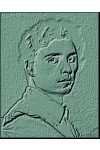Pronunciation:

Jean Auguste Dominique Ingres was born on August 29, 1780 in Montauban, now the principal city of Tarn-et-Garonne.
Introduced to the arts by his father, himself a sculptor and painter, Ingres entered the Toulouse Academy in 1791. Five years later he became a student of Jacques-Louis David in Paris.
He won the Prix de Rome in 1801 for his second painting "Ambassadors of Agamemnon in the tent of Achilles” which led to a commission from the First Consul in 1803. Within a few weeks, he produced a full-length portrait of Bonaparte as First Consul in Liège without any sitting being granted by his illustrious subject.
The vicissitudes of the Napoleonic Wars allowed him to visit Rome in 1806 where the works of Raphael, as well as from the Quattrocento, began influencing his style. During his time in Rome (which he extended due to the lack of interest in his paintings in France), he produced several nudes (including the famous "The Bather"), landscapes, portraits and historical studies.
He displayed his Napoleon I on his Imperial Throne at the Salon in 1806. This work depicts the Emperor with all the symbols of his power: imperial eagles on the throne and tapestry, Charlemagne's scepter, the hand of justice, a crown of golden laurels, a satin tunic embroidered with gold, a royal velvet cloak with gold bees, an ermine hood, the large collar of the Order of the Legion of Honour, the coronation sword and a silk sash! The painting was accepted by the Legislature (Corps législatif).
In 1811, his painting Jupiter and Thetis showed the king of the gods in the same pose suggesting that the artist was hinting at a connection that even the most zealous historians would have had trouble establishing...
Following his marriage to Madeleine Chapelle in 1813, he produced several paintings and drawings of his young wife. One of these sketches would inspire the artist more than 40 years later when he immortalized Madeleine in the celebrated Turkish Bath of 1862.
In 1814 he completed a commission for Caroline Murat that would become one of his most successful works. The three additional vertebrae of La Grande Odalisque as well as her beauty have been the subjects of two centuries of commentary.
The fall of the Empire spelled semi-anonymity and financial hardship for Ingres until the success of the Vow of Louis XIII at the Salon of 1824. Now triumphant, he was elected to the Institute as successor of Dominique Vivant-Denon.
His works from this period were as divers as they were successful: Apotheosis of Homer, 1827; portraits of Monsieur Bertin (the press baron Louis-François Bertin), 1832 and of Mathieu-Louis Molé, 1824; Odalisque with Slave and Portrait of Luigi Cherubini, 1842; portraits of Louise de Broglie, the Countess d'Haussonville, 1845, Madame Moitessier, 1845 and of Madame Gonse, 1852; Joan of Arc at the Coronation of Charles VII, 1854 and The Turkish Bath, 1862 (cut into a circular form by the artist in 1863) which was the masterpiece of an artist who was still at the height of his art at 82.
Jean Auguste Dominique Ingres died on January 14, 1867 in Paris. He left the proceeds from his atelier to his native city that had created a museum bearing his name in 1851 thanks to a gift from an artist anxious to safeguard his legacy. He is buried in the 23rd division of the Père Lachaise Cemetary .
Ingres dominated the European art scene at the beginning of the 19th century due to his technical perfection and incomparable stylistic. He belongs to a classical tradition that began with the memory of Raphael's importance and noble heritage. The label "neoclassical" is all the more established among art historians since Ingres' contemporary Eugène Delacroix (18 years his junior though he died 4 years before him) incarnated in their eyes the genius of Romanticism.
Ingres was also a violinist. He even played second violin in the Orchestre du Capitole in Toulouse for a time. The French expression "violon d'Ingres" ("Ingres' violin") today means a pastime undertaken with considerable talent.
"Jean Auguste Dominique Ingres". Self-portrait.

The Postal Service of the Union of Soviet Socialist Republics released a 32-kopek stamp in 1980 bearing the image of Jean Auguste Dominique Ingres .
Acknowledgements
Other portraits

Enlarge
"Jean Auguste Dominique Ingres". Self-portrait.

Enlarge
"Jean Auguste Dominique Ingres". Self-portrait, 1859.

Enlarge
"Jean Auguste Dominique Ingres". Photograph by Pierre Petit (Aups 1831 - Paris 1909).